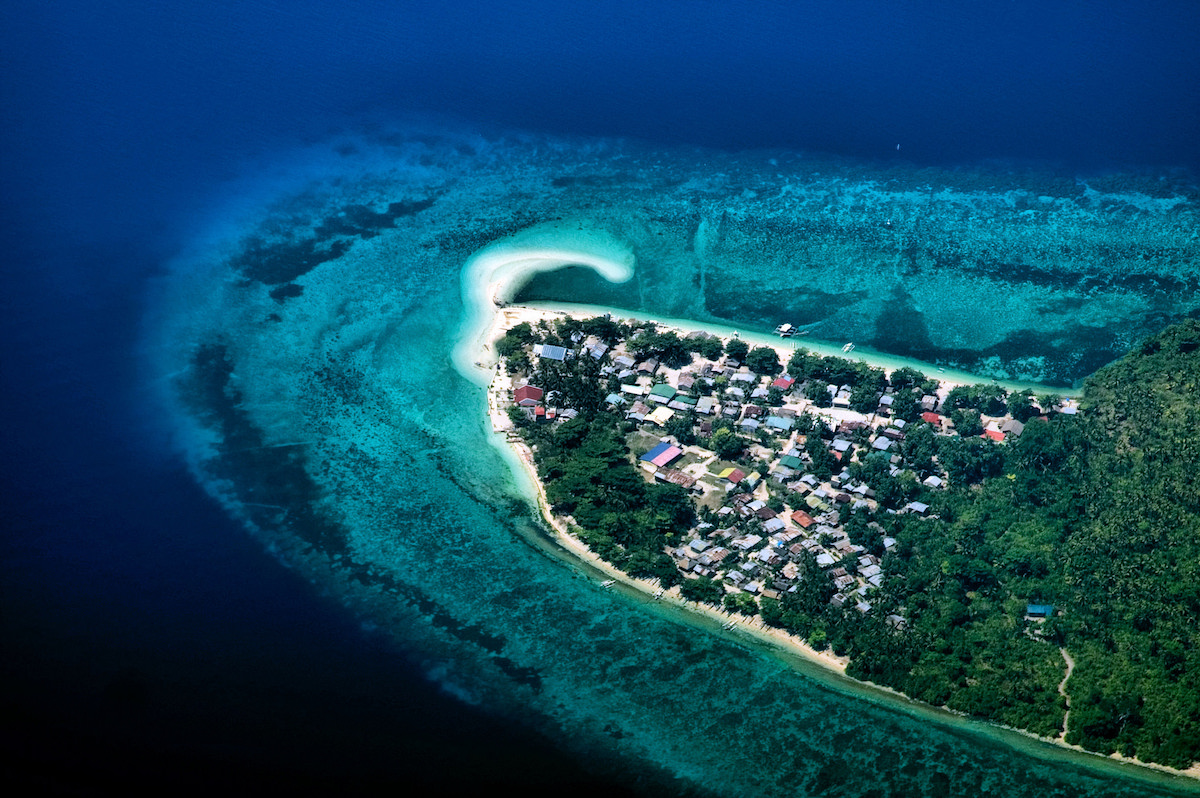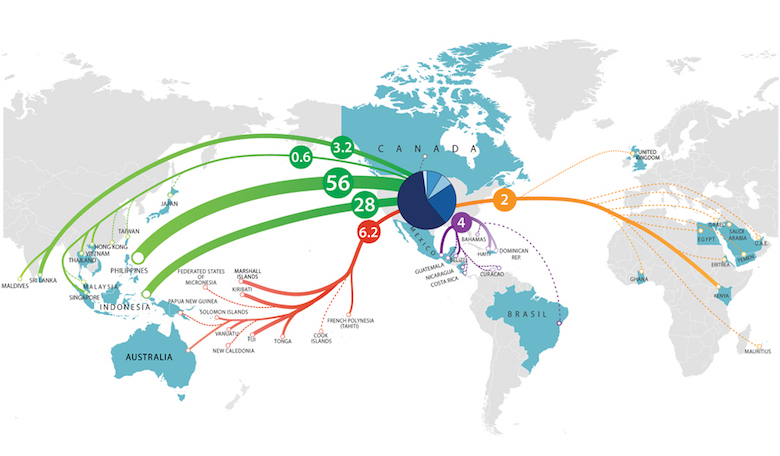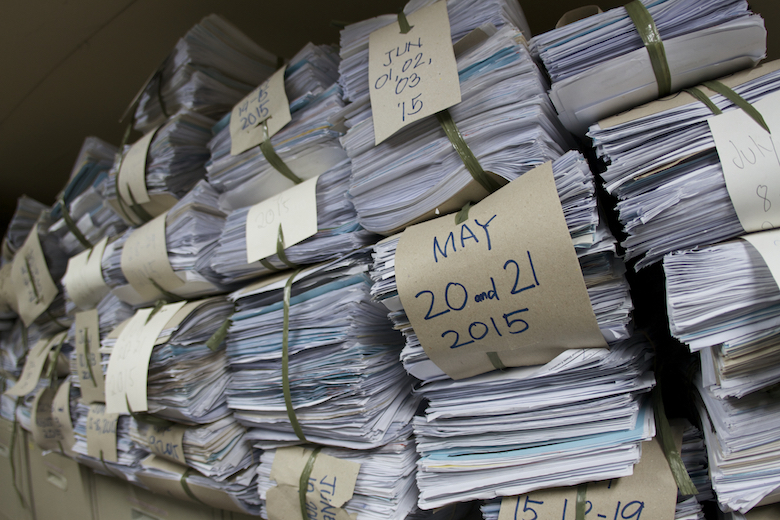- Between 18 and 30 million marine aquarium fishes are traded globally each year, but a paucity of data makes it difficult to know the actual volume.
- While some observers argue that the trade can be a force for reef conservation and socio-economic development, some of the same voices also caution that the trade as it is currently practiced may be tough on reef ecosystems and fisher communities in certain places.
- A pair of researchers have developed new technology to quantify the trade in hopes of putting it on a path to sustainability. After successfully using it to analyze US imports, they are now attempting to assess the world’s most important source country for marine aquarium fishes — the Philippines.
Crisanto sorted his catch in a humid, non-descript concrete building that whirred and hummed as pumps moved water through hundreds of acrylic cubes containing brightly colored tropical reef fishes. A fisherman with weather-beaten skin, apparently in his 40s, he said he has collected aquarium fishes for most of his adult life.
His village, on the Philippine island of Cebu, is a place foreigners see predominantly for its palm-fringed beaches. But while tourists flock to the island, the only islanders leaving in droves for foreign destinations are its fish.
Crisanto was surprised to learn that his country provides the majority of saltwater aquarium fishes to global markets. And he was shocked to hear what foreign aquarium hobbyists pay for fishes — in some cases a hundred or more times what the fisher makes for each one. What he does know is the poverty that surrounds him — the piles of rotting refuse along the street, the makeshift shacks of rusted corrugated tin draped with storm-beaten tarps. More than 66 percent of the region’s families are low-income or poor according to government statistics.

In this hardscrabble setting, it’s hard to conjure the mini reefs reproduced in living rooms of landlocked, well-fed Westerners. Yet that will likely be the final destination for the twospined angelfish (Centropyge bispinosa), an iridescent indigo creature with a flash of orange on its sides, that Crisanto transferred from a tub into a water-filled plastic bag for shipping. After a long flight, the fish will sell to an aquarium hobbyist for up to $40 — close to many Filipinos’ entire weekly earnings.
Researchers who study the aquarium trade believe anywhere from 18 to 30 million marine fishes are traded globally each year, but a paucity of data makes it difficult to know the actual volume. While some observers argue that the trade can be a force for reef conservation and socio-economic development in places like the Philippines, some of the same voices also caution that the trade as it is currently practiced may be tough on reef ecosystems and fisher communities in certain places.
Data is the key to putting the trade on a path toward greater sustainability, according to researchers Michael Tlusty of the New England Aquarium in Boston and Andrew Rhyne of the aquarium and Roger Williams University in Bristol, Rhode Island. The pair has developed a new way to collect and interpret information about the diversity and volume of animals in commerce. After successfully using their approach to analyze US imports, they are now cooperating with the Philippines government to assess the world’s most important source country for marine aquarium fishes.
A contentious global industry
The saltwater aquarium trade emerged in the 1930s in Sri Lanka. By the 1970s it had grown into a multi-million-dollar global industry. The trade reached its peak in 2005 then declined, in part due to the global economic downturn. Now, however, numbers appear to be rising again, according to Rhyne.
Their analysis of US import data from between 2008 and 2011 show that nearly 2,300 fish species originating from 45 countries are in trade, most arriving from the Philippines (56 percent), followed by Indonesia (28 percent). The majority of the global trade goes to the US (up to 70 percent) and Europe. Observers note that aquarium keeping is on the rise across Southeast Asia and especially in China, which could shift trade demographics significantly over the next decade.

The saltwater aquarium trade remains firmly dependent on wild fishes. Less than 15 percent of the marine fish species in trade have been successfully bred and raised in captivity, and only around 1 percent is commonly available as aquacultured specimens. Aquacultured corals, however, are far more common.
Some anti-aquarium activists and NGOs contend that the extraction of reef fishes for aquaria is tantamount to a crime against nature. Not infrequently, opponents use charged language such as “rape” and “enslave” to describe what the trade does to reefs and fishes, and their arguments tend to be more about animal welfare and ethics than fishery sustainability. Anti-trade activists like the Humane Society of the United States and Sea Shepherd Conservation Society would like to see the trade either ended altogether or restricted to captive-bred animals. But with so few aquacultured fishes available, it seems unlikely the industry will voluntarily move in that direction. As a result, activists increasingly rely on legislation, litigation, and Endangered Species Act petitions to try to curb or eliminate the trade.
When it comes to the sustainability of the aquarium fishery, there are some examples of localized overfishing. In at least one case — that of one of the most popular aquarium fishes, the Banggai cardinalfish (Pterapogon kauderni) — overfishing caused concern among scientists about the viability of an entire species. Just this week, the US National Marine Fisheries Service (NMFS) listed the Banggai cardinalfish as “threatened” under the Endangered Species Act.

Overall, however, overfishing aquarium fisheries is unlikely given the reproductive biology of many of the most popular species, Rhyne told Mongabay. “Many species are traded in such small numbers and are so fecund that few aquarium fisheries could harvest anywhere close to the maximum sustainable yield based on current demand,” he said.
Nonetheless, he cautions that species traded in large numbers, or those harvested from geographically restricted ranges, must be monitored more closely. “The trade only has limited examples of successful management of heavily traded species,” he said.
While 30 million fishes harvested in a year sounds like a lot, especially on top of well-documented reef stressors like coral bleaching and ocean acidification, it pales in comparison to food fisheries, where the accidental bycatch alone is far greater than the entire aquarium fishery harvest.
Nonetheless, even many proponents of the trade acknowledge widespread illegal, unreported, and unregulated fishing. These include the ongoing use of cyanide to stun fishes despite PR campaigns to end the practice and laws making it illegal in the two largest source countries. They acknowledge that localized overfishing has forced fishers in some areas to go farther afield to find high-value species like the blue tang (Paracanthurus hepatus).

On the import side, those familiar with marine aquarium fish shipments say misidentified and improperly declared animals remain too common, in some cases representing a clear effort to subvert regulations and restrictions. Many observers agree that efforts to reform the trade have largely failed owing to a lack of transparency and to the fact that the most important source countries have poor track records when it comes to illegal wildlife trafficking.
Tlusty and Rhyne share some of these concerns. But the scientists believe that closing marine aquarium fisheries could have serious consequences for fishers like Crisanto, as well as for reefs. They argue that a low-biomass, high-value fishery like an aquarium fishery can actually motivate people to harvest sustainably and to conserve coral reefs.
“If this fishery is shuttered, what opportunities are left?” Tlusty said in an interview with Mongabay. “These are fishermen, and if they can’t catch fish for the aquarium trade, they will often just fish for the same species for food harder.”
A need for data
For more than a decade, researchers have been discussing the lack of sufficient marine aquarium trade data: How many fish? Which species? Where are they harvested? Where are they sent? While several databases of trade data exist, none of them were designed to comprehensively monitor trade or to provide the kind of species-specific data needed to support decisions about sustainability. Yet Rhyne and Tlusty argue that without this data, increasing the sustainability of the trade is nearly impossible because it is difficult to know what effect trade is having on the environmental and socio-economic situation in source countries and therefore how fisheries and trade should be managed.
“When you don’t even know how many animals are being exported from a given country, how can you begin to assess whether that number is sustainable or not?” Rhyne said.
The tools Rhyne and Tlusty have developed have their origins with a coral reef ecologist named Andrew Bruckner. In the early 2000s Bruckner was working at the National Oceanic and Atmospheric Administration (NOAA) to improve conservation, management, and restoration actions for coral reefs. In 2004, he began collecting import data from the US Fish and Wildlife Service in an effort to better understand the true volume and diversity of the marine aquarium trade. The agency is responsible for inspecting wildlife imports, and wildlife inspectors record import data in a database called the Law Enforcement Management Information System (LEMIS). Unfortunately for Bruckner, most species of saltwater aquarium fishes are lumped together in LEMIS under a single generic code: MATF, for marine tropical fish. Bruckner realized, however, that the commercial invoices that accompany imports identify most fish down to the species level, and the agency was archiving these in paper form. The challenge then became getting the data from often poor-quality invoices into a database for analysis.
In 2008 Bruckner passed this challenge off to Rhyne in the form of twelve boxes of paper invoices he’d received from the agency. The need to digitize them grew increasingly apparent as the project grew and the number of invoices surpassed 20,000, some as long as 20 pages. Errors, a lack of standardization, and poor legibility made manual data entry unrealistic, even with a team of students.
To overcome this challenge, Rhyne customized optical character recognition software to interpret wildlife shipments. The software could verify species names and identify potential errors in scanned invoices, and it increased the team’s workflow dramatically. For example, it could identify an invalid scientific name or flag and correct a synonym. It could identify the type of data contained in a column — such as scientific name, quantity, or price — and put it in the right place in the database Rhyne, Tlusty, and two colleagues were building. The end result was the Marine Aquarium Biodiversity and Trade Flow database published this summer.
Even before the database was published, it proved its utility in several high-profile cases. For example, in 2012 the Arizona-based NGO Center for Biological Diversity sought to list the orange clownfish (Amphiprion percula) under the Endangered Species Act, expressing concern that the aquarium trade was harvesting almost half a million of these fish from reefs each year. Rhyne used a prototype of the system he was building to take a closer look at the data and shared his results with NMFS to inform its review of the case. The agency ultimately determined that the number of globally traded wild orange clownfish was likely around 70,000 to 100,000, representing less than 0.0076 percent of the wild population. Citing Rhyne, Tlusty and their colleagues, NMFS declined to list the species.

In addition to providing invaluable and previously unavailable data on the aquarium trade, those charged with overseeing other aspects of the wildlife trade also see the utility of Rhyne and Tlusty’s system. A real-time, tablet-based version of the technology could increase the efficacy of wildlife inspectors at ports of entry and help identify illegal trade, for instance. The work recently earned the New England Aquarium a finalist slot in USAID’s Wildlife Crime Tech Challenge, a contest that rewards science and technology innovations to combat wildlife trafficking.
“This database is the starting point for increasing the sustainability of the trade,” Rhyne said, “Once we know the volume and diversity of the trade, we can tackle other relevant issues that lead to environmental and economic benefits.”
Taking the system to the reef
Last March the Philippine Undersecretary for Fisheries, Asis Perez, signed a memorandum of understanding with the New England Aquarium. The MOU allows Rhyne and his colleagues to assist the Philippine Bureau of Fisheries and Aquatic Resources (BFAR) in collecting export data and then analyzing it with their new system. In October Rhyne traveled to the Philippines to meet with BFAR staff and install hardware and software enabling them to easily scan invoices and other export documents for transmission back to Roger Williams University. The team there then moves the scans into the database using the custom optical character recognition software.

The project is funded through a roughly $50,000 NOAA grant and will provide at least one year’s worth of export data from the Philippines.
The Philippine government’s willingness to collaborate with Rhyne and his colleagues is a potential game-changer for the embattled marine aquarium trade. If the largest source country can carry out data-based reform, such as implementing data-based fisheries management and more effectively regulating exports, the trade could demonstrate it is on a path to greater sustainability that can benefit fishers, fisher communities, and reefs.
Perez is the driving force behind the country’s participation. Prior to his appointment as undersecretary, he was an environmental lawyer who believed the marine aquarium trade in the Philippines should be shut down. Despite numerous efforts over the years by NGOs and others to reform the country’s aquarium fisheries, when Perez took his post in 2011, cyanide use and other destructive, illegal activities remained common.
In his first months on the job, Perez took a closer look at the aquarium fishery, and what he learned was similar to what Rhyne and Tlusty believe — that a sustainable aquarium fishery can be a force for lifting coastal people out of poverty and conserving reefs.
After signing the MOU, Perez recalled in an interview how he met with aquarium-fish exporters in Manila early in his tenure as undersecretary. “I told them the mandate of our president is very, very clear — to take out all unsustainable practices because in the long run it creates poverty.”
His message to the aquarium trade was equally clear: it would operate sustainably, or he would shut it down completely. While licensing fishers, registering boats, enforcing laws, and creating new laws are all central to a sustainable future for the Philippines’ fisheries, Perez said that none of it can be done without data and transparency.
Citations
Rhyne, A.L., Tlusty, M.F., Szczebak, J., Holmberg, R.J. (2015). When one code = 2,300 species: Expanding our understanding of the trade in aquatic marine wildlife. PeerJ PrePrints 3:e1447.
